IoT Arduino UNO, RaspberryPi with Python, RaspberryPi Programming using Python and Smart City
- 1. Internet of Things ( Elective -2 ) Sub Code: 18ISDE712 Module 4: IoT Physical Devices and End points and RaspberryPi Introduction to RaspberryPi Arduino UNO, RaspberryPi with Python and Smart City
- 2. Module 4 : Arduino UNO, RaspberryPi with Python and Module 5 : RaspberryPi Programming using Pythonand Smart City IoT Physical Devices and Endpoints Arduino UNO: Introduction to Arduino, • Arduino UNO, Installing the Software, • Fundamentals of Arduino Programming. • IoT Physical Devices and Endpoints. RaspberryPi: Introduction to RaspberryPi, • About the RaspberryPi Board: Hardware Layout, • Operating Systems on RaspberryPi, Configuring. RaspberryPi, • Programming RaspberryPi with Python, • Wireless Temperature Monitoring System Using Pi, • DS18B20 Temperature Sensor, • Connecting Raspberry Pi via SSH, • Accessing Temperature from DS18B20 sensors, • Remote access to RaspberryPi. Smart cities: Smart and Connected Cities, • An IoT Strategy for Smarter Cities, • Smart City IoT Architecture, • Smart City Security Architecture, • Smart City Use-Case Examples Internet of Things(Elective 2) Prepared by Dr. MK Jayanthi Kannan
- 3. 2 Course Specification By Dr. M.K. Jayanthi Kannan, M.E.,MS.,MBA., M.Phil., Ph.D., Professor and HOD ISE, Faculty of Engineering & Technology, JAIN Deemed To-Be University, Bengaluru. Staff Room: 324- 8. Office Hours : 8.30 AM -4 PM Department of Computer Science and Engineering, FET Block, Internet of Things ( Elective 2) by Dr.M.K.Jayanthi Kannan
- 4. Internet of Things ( Elective -2 ) Unit : 4 IoT Physical Devices and Endpoints Internet of Things(Elective 2) Prepared by Dr. MK Jayanthi Kannan
- 5. Internet Of Things Technology Sub Code: 18ISDE712 IoT Physical Devices and Endpoints Arduino UNO: Introduction to Arduino, • Arduino UNO, Installing the Software, • Fundamentals of Arduino Programming. • IoT Physical Devices and Endpoints. RaspberryPi: Introduction to RaspberryPi, • About the RaspberryPi Board: Hardware Layout, • Operating Systems on RaspberryPi, Configuring. 5 Internet of Things(Elective 2) Prepared by Dr. MK Jayanthi Kannan
- 6. Module – 5 IoT Physical Devices and End Point-Aurdino Uno 6 Arduino: Arduino is an open-source electronics platform based on easy- to-use hardware and software. Arduino boards are able to read inputs - light on a sensor, a finger on a button, or a Twitter message - and turn it into an output - activating a motor, turning on an LED, publishing something online. Internet of Things(Elective 2) Prepared by Dr. MK Jayanthi Kannan
- 7. Module – 5 IoT Physical Devices and End Point- Aurdino Uno 7 Arduino UNO: Arduino Uno is a microcontroller board based on the ATmega328P . It has 14 digital input/output pins (of which 6 can be used as PWM outputs), 6 analog inputs, a 16 MHz quartz crystal, a USB connection, a power jack, an ICSP header and a reset button. "Uno" means one in Italian and was chosen to mark the release of Arduino Software (IDE) 1.0. The Uno board and version 1.0 of Arduino Software (IDE) were the reference versions of Arduino, now evolved to newer releases. Internet of Things(Elective 2) Prepared by Dr. MK Jayanthi Kannan
- 8. Module – 4 IoT Physical Devices and End Point- Aurdino Uno 8 Internet of Things(Elective 2) Prepared by Dr. MK Jayanthi Kannan
- 9. 1. Reset Button – This will restart any code that is loaded tothe Arduino board 2. AREF – Stands for “Analog Reference” and is used to set an external reference voltage 3. Ground Pin – There are a few ground pins on the Arduinoand they all work thesame 5. PWM – The pins marked with the (~) symbol cansimulate analogoutput 6. USB Connection – Used for powering up your Arduino and uploading sketches 7. TX/RX – Transmit and receive data indicationLEDs 10. Voltage Regulator – This controls the amount of voltage going into the Arduino board 11. DC Power Barrel Jack – This is used for poweringyour Arduino with a power supply 4.Digital Input/Output – Pins 0-13 can be used for digital input or output 12. 3.3V Pin – This pin supplies 3.3 volts of power to your projects 13. 5V Pin – This pin supplies 5 volts of power to your projects 14. Ground Pins – There are a few ground pins on theArduino and they all work the same 15. Analog Pins – These pins can read the signal from ananalog sensor and convert it to digital 9 Module – 5 IoT Physical Devices and End Point- Aurdino Uno 9. Power LED Indicator – This LED lights up anytime the board is plugged in a power source Internet of Things(Elective 2) Prepared by Dr. MK Jayanthi Kannan
- 10. Aurdino Uno 1.Reset Button – This will restart any code that is loaded tothe Arduino board 2.AREF – Stands for “Analog Reference” and is used to set an external reference voltage 3.Ground Pin – There are a few ground pins on the Arduinoand they all work thesame 4.Digital Input/Output – Pins 0-13 can be used for digital input or output 5.PWM – The pins marked with the (~) symbol cansimulate analogoutput 6.USB Connection – Used for powering up your Arduino and uploading sketches 7. TX/RX – Transmit and receive data indicationLEDs 9 Internet of Things(Elective 2) Prepared by Dr. MK Jayanthi Kannan
- 11. 10. Voltage Regulator – This controls the amount of voltage going into the Arduino board 11.DC Power Barrel Jack – This is used for powering your Arduino with a power supply 12 3.3V Pin – This pin supplies 3.3 volts of power to your projects output 13.5V Pin – This pin supplies 5 volts of power to your projects 14.Ground Pins – There are a few ground pins on the Arduino and they all work the same 15. Analog Pins – These pins can read the signal from an analog sensor and convert it to digital 9 9. Power LED Indicator – This LED lights up anytime the board is plugged in a power source Internet of Things(Elective 2) Prepared by Dr. MK Jayanthi Kannan
- 12. Module – 5 IoT Physical Devices and End Point-Aurdino Uno 10 Fundamentals of Arduino Programming: Two required functions / methods / routines: void setup() { // runs once } void loop() { // repeats } Internet of Things(Elective 2) Prepared by Dr. MK Jayanthi Kannan
- 13. digitalWrite() analogWrite() digitalRead() if() statements / Boolean analogRead() BIG 6 CONCEPTS Internet of Things(Elective 2) Prepared by Dr. MK Jayanthi Kannan
- 14. Comments, Comments, Comments Comments // this is for single line comments // it’s good to put at the top and before anything ‘tricky’ /* this is for multi-line comments Like this… And this…. */ Internet of Things(Elective 2) Prepared by Dr. MK Jayanthi Kannan
- 15. comments Internet of Things(Elective 2) Prepared by Dr. MK Jayanthi Kannan
- 16. Three commands to know… pinMode(pin, INPUT/OUTPUT); ex: pinMode(13, OUTPUT); digitalWrite(pin, HIGH/LOW); ex: digitalWrite(13, HIGH); delay(time_ms); ex: delay(2500); // delay of 2.5 sec. // NOTE: -> commands are CASE-sensitive Internet of Things(Elective 2) Prepared by Dr. MK Jayanthi Kannan
- 17. Arduino Code Basics Arduino programs run on two basic sections: void setup() { //setup motors, sensors etc } void loop() { // get information from sensors // send commands to motors } Internet of Things(Elective 2) Prepared by Dr. MK Jayanthi Kannan
- 18. SETUP 16 The setup section is used for assigning input and outputs . (Examples: motors, LED’s, sensors etc) to ports on the Arduino It also specifies whether the device is OUTPUT or INPUT T o do this we use the command “pinMode” Internet of Things(Elective 2) Prepared by Dr. MK Jayanthi Kannan
- 19. SETUP } void setup() { port # pinMode(9, OUTPUT); Input or Output Internet of Things(Elective 2) Prepared by Dr. MK Jayanthi Kannan
- 20. void loop() { } LOOP Port # from setup digitalWrite(9, HIGH); delay(1000); digitalWrite(9, LOW); delay(1000); Turn the LED on or off Wait for 1 second or 1000 milliseconds Internet of Things(Elective 2) Prepared by Dr. MK Jayanthi Kannan
- 21. int val = 5; DECLARING A VARIABLE Type assignment “becomes” variable name value Internet of Things(Elective 2) Prepared by Dr. MK Jayanthi Kannan
- 22. USING VARIABLES int delayTime = 2000; int greenLED = 9; void setup() { Declare delayTime pinMode(greenLED, OUTPUT)V;ariable } void loop() { digitalWrite(greenLED, HIGH); delay(delayTime); Use delayTime digitalWrite(greenLED, LOW ); a ri able delay(delayTime); } Internet of Things(Elective 2) Prepared by Dr. MK Jayanthi Kannan
- 23. Using Variables int delayTime = 2000; int greenLED = 9; } void setup() { pinMode(greenLED, OUTPUT); } void loop() { digitalWrite(greenLED, HIGH); delay(delayTime); digitalWrite(greenLED, LOW); delayTime = delayTime - 100; delay(delayTime); subtract 100 from delayTime to gradually increase LED’s blinking speed Internet of Things(Elective 2) Prepared by Dr. MK Jayanthi Kannan
- 24. Conditions T o make decisions in Arduino code we use an ‘if’ statement ‘If’ statements are based on a TRUE or FALSE question Internet of Things(Elective 2) Prepared by Dr. MK Jayanthi Kannan
- 25. VALUE COMPARISONS GREATER THAN a > b LESS a < b EQUAL GREATER THAN OR EQUAL a >= b LESS THAN OR EQUAL a <= b NOT EQUAL Internet of Things(Elective 2) Prepared by Dr. MK Jayanthi Kannan
- 26. IF Condition if(true) { “perform some action” } Internet of Things(Elective 2) Prepared by Dr. MK Jayanthi Kannan
- 27. int counter = 0; void setup() { Serial.begin(9600); } void loop() { if(counter < 10) { Serial.println(counter); } counter = counter + 1; } IF Example Internet of Things(Elective 2) Prepared by Dr. MK Jayanthi Kannan
- 28. Input & Output Transferring data from the computer to an Arduino is done using Serial Transmission Tosetup Serial communication we use the following 26 void setup() { Serial.begin(9600); } Internet of Things(Elective 2) Prepared by Dr. MK Jayanthi Kannan
- 29. Writing to the Console void setup() { Serial.begin(9600); Serial.println(“Hello World!”); } void loop() {} Internet of Things(Elective 2) Prepared by Dr. MK Jayanthi Kannan
- 30. IF - ELSE Condition if( “answer is true”) { “perform some action” } else { “perform some other action” } Internet of Things(Elective 2) Prepared by Dr. MK Jayanthi Kannan
- 31. int counter = 0; void setup() { Serial.begin(9600); } void loop() { if(counter < 10) { Serial.println(“less than 10”); } else {Serial.println(“greater than or equal to 10”); Serial.end(); } counter = counter + 1;} IF - ELSE Example Internet of Things(Elective 2) Prepared by Dr. MK Jayanthi Kannan
- 32. IF - ELSE IF Condition if( “answer is true”) { “perform some action” } else if( “answer is true”) { “perform some other action” } Internet of Things(Elective 2) Prepared by Dr. MK Jayanthi Kannan
- 33. int counter = 0; void setup() { Serial.begin(9600); } void loop() { } IF - ELSE Example if(counter < 10) { Serial.println(“less than 10”); } else if (counter == 10) { Serial.println(“equal to 10”); } else { Serial.println(“greater than 10”); Serial.end(); } counter = counter + 1; IoT _Arduino UNO, RaspberryPi with Pythonand Smart City
- 34. BOOLEAN OPERATORS - AND 32 If we want all of the conditions to be true we need to use ‘AND’ logic (AND gate) We use the symbols && • Example if ( val > 10 && val < 20) Internet of Things(Elective 2) Prepared by Dr. MK Jayanthi Kannan
- 35. BOOLEAN OPERATORS - OR 33 If we want either of the conditions to be true we need to use ‘OR’ logic (OR gate) We use the symbols || • Example if ( val < 10 || val > 20) Internet of Things(Elective 2) Prepared by Dr. MK Jayanthi Kannan
- 36. BOOLEAN VARIABLES boolean done = true; boolean done = false; void setup() { Serial.begin(9600);} void loop() { if(!done) { Serial.println(“HELLOWORLD”); done = true; } Internet of Things(Elective 2) Prepared by Dr. MK Jayanthi Kannan
- 37. Important functions • Serial.println(value); – Prints the value to the Serial Monitor on your computer • pinMode(pin, mode); – Configures a digital pin to read (input) or write (output) a digital value • digitalRead(pin); – Reads a digital value (HIGH or LOW) on a pin set for input • digitalWrite(pin, value); – Writes the digital value (HIGH or LOW) to a pin set for output Internet of Things(Elective 2) Prepared by Dr. MK Jayanthi Kannan
- 38. • Essential Programming Concepts – Delay – Infinite Loop • General Input/Output – Polling or Busy/Wait I/O – Interrupt Processing • Timers and Internal Inteerrupts • High-Level Language Extensions • Code Transformations for Embedded Computing – Loop Unrolling – Loop Merging – Loop Peeling – Loop Tiling OUTLINE Internet of Things(Elective 2) Prepared by Dr. MK Jayanthi Kannan
- 39. • Delays are essential in embedded systems, unlike high- performance systems where we want the program to execute as fast as possible • Delays are used to synchronize events, or read inputs with a specific sampling freqency (more on Bus/Wait I/O) DELAY (1/3) Internet of Things(Elective 2) Prepared by Dr. MK Jayanthi Kannan
- 40. • Okay, so how do we build a delay function? • Our reference is the system clock frequency • We use a register or a timer to measure ticks • Each tick is 1/frequency • Example: Assuming a 16-bit processor, an increment and a jump instruction is 1-cycle each and a 10 MHz system clock, build a 1-sec delay: • T = 1/10 MHz = 100 ns • 1 s/100 ns = 10,000,000 int i=5000000; //2 ticks per iteration BACK: i--; if (i!=0) goto BACK; DELAY (3/3) Internet of Things(Elective 2) Prepared by Dr. MK Jayanthi Kannan
- 41. • Embedded Systems are mostly single-functioned • Their core application never terminates • Infinite loops are not forbidden as long as they are done correctly Infinite Loop (1/2) Internet of Things(Elective 2) Prepared by Dr. MK Jayanthi Kannan
- 42. void main() { light enum {RED, ORANGE, GREEN}; loop: light = RED; //no exit from loop! delay(20000); //20-sec red light = ORANGE; //2-sed orange delay(2000); light = GREEN; delay(20000); goto loop; //20-sec green //just repeat sequence } Infinite Loop (2/2) Internet of Things(Elective 2) Prepared by Dr. MK Jayanthi Kannan
- 43. Module 4: IoT Physical Devices and End : RaspberryPi RaspberryPi: Raspberry Pi is the name of a series of single-board computers made by the Raspberry Pi Foundation, a UK charity that aims to educate people in computing and create easier access to computing education. The Raspberry Pi launched in 2012, and there have been several iterations and variations released since then. The original Pi had a single-core 700MHz CPU and just 256MB RAM, and the latest model has a quad-core 1.4GHz CPU with 1GB RAM. The main price point for Raspberry Pi has always been $35 and all models have been $35 or less, including the Pi Zero, which costs just $5. 41 Internet of Things(Elective 2) Prepared by Dr. MK Jayanthi Kannan
- 44. Module – 5 IoT Physical Devices and End Dr. Syed Mustafa, HKBKCE. 9 May 2020
- 45. Module – 5 IoT Physical Devices and End 9 May 2020 Internet of Things(Elective 2) Prepared by Dr ,MK.Jayanthi Kannan
- 46. Module – 5 IoT Physical Devices and End Dr. Syed Mustafa, HKBKCE. 9 May 2020
- 47. Module – 5 IoT Physical Devices and End Hardware Layout: raspi-config • The Raspberry Pi configuration tool in Raspbian, allowing you to easily enable features such as the camera, and to change your specific settings such as keyboard layout config.txt • The Raspberry Pi configuration file Wireless networking • Configuring your Pi to connect to a wireless network using the Raspberry Pi 3's or Pi Zero W's inbuilt wireless connectivity, or a USB wireless dongle Wireless access point • Configuring your Pi as a wireless access point using the Raspberry Pi 3 and Pi Zero W's inbuilt wireless connectivity, or a USB wireless dongle Internet of Things(Elective 2) Prepared by Dr ,MK.Jayanthi Kannan
- 48. Module – 5 IoT Physical Devices and End Point- Aurdino Uno Using a proxy • Setting up your Pi to access the internet via a proxy server HDMI Config • Guide to setting up your HDMI device, including custom settings Audio config • Switch your audio output between HDMI and the 3.5mm jack Camera config • Installing and setting up the Raspberry Pi camera board External storage config • Mounting and setting up external storage on a Raspberry Pi Internet of Things(Elective 2) Prepared by Dr. MK.Jayanthi Kannan
- 49. Module – 5 IoT Physical Devices and End Point- Aurdino Uno Localisation • Setting up your Pi to work in your local language/time zone Default pin configuration •Changing the default pin states. Device Trees config •Device Trees, overlays, and parameters Kernel command line •How to set options in the kernel command line UART configuration • How to set up the on-board UARTS. Firmware warning icons • Description of warning icons displayed if the firmware detects Internet of Things(Elective 2) Prepared by Dr. MK Jayanthi Kannan
- 50. Module – 5 IoT Physical Devices and End LED warning flash codes • Description of the meaning of LED warning flashes that are shown if aPi fails to boot or has to shut down Securing your Raspberry Pi • Some basic advice for making your Raspberry Pi more secure Screensaver • How to configure screen blanking/screen saver The boot folder • What it's for and what's in it Internet of Things(Elective 2) Prepared by Dr. MK Jayanthi Kannan
- 51. MODULE 5 : RaspberryPi Programming using Python RaspberryPi, • Programming RaspberryPi with Python, • Wireless Temperature Monitoring System Using Pi, • DS18B20 Temperature Sensor, • Connecting Raspberry Pi via SSH, • Accessing Temperature from DS18B20 sensors, • Remote access to RaspberryPi. Smart cities: Smart and Connected Cities, • An IoT Strategy for Smarter Cities, • Smart City IoT Architecture, • Smart City Security Architecture, • Smart City Use-Case Examples
- 52. Operating Systems on RaspberryPi: • You have a few options when it comes to interacting with the Raspberry Pi. •The first and most common is to use it like you would a full desktop computer (just smaller). •This involves connecting a keyboard, mouse, and monitor. With this setup, you are likely best served by installing Raspbian with Desktop, which gives you a full graphical user interface(GUI) to work with. •This is the best option if you want an experience similar to working with other operating systems (OS), such as Windows, macOS, or other popular Linux flavors, like Ubuntu. Internet of Things(Elective 2) Prepared by Dr. MK Jayanthi Kannan
- 53. Module – 5 IoT Physical Devices and End Programming RaspberryPi with Python: The Raspberry Pi is an amazing single board computer (SBC) capable of running Linux and a whole host of applications. Python is a beginner-friendly programming language that is used in schools, web development, scientific research, and inmany other industries. Internet of Things(Elective 2) Prepared by Dr. MK Jayanthi Kannan
- 54. Wireless Temperature Monitoring System Using Pi: Raspberry Pi which having inbuilt wi-fi, which makes Raspberry Pi to suitable for IoT applications, so that by using IoT technology this monitoring system works by uploading the temperature value to the Thingspeak cloud by this project you can able to learn to how to handle cloud- based application using API keys. In this monitoring system, we used Thingspeak cloud, the cloud which is suitable to view the sensor logs in the form of graph plots. Here we created one field to monitor the temperature value, that can be reconfigurable to monitor a number of sensor values in various fields. This basic will teach you to how to work with a cloud by using LM35 as a temperature sensor, to detect the temperature and to upload those values into the cloud.
- 55. Module – 5 IoT Physical Devices and End 9 May 2020 IoT _Arduino UNO, RaspberryPi with Python and Smart City HARDWARE REQUIRED • Raspberry Pi • SD card • Power supply • VGA to HDMI converter (Optional) • MCP3008 (ADC IC) • A temperature sensor(LM35) SOFTWARE REQUIRED • Raspbian Stretch OS • SD card Formatter • Win32DiskImager (or) Etcher PYTHON LIBRARIES USED • RPi.GPIO as GPIO (To access the GPIO Pins of Raspberry Pi) • Time library (For Time delay) • Urllib2 to handle URL using Python programming
- 56. DS18B20 Temperature Sensor 9 May 2020 IoT _Arduino UNO, RaspberryPi with Python and Smart City The DS18B20 is a 1-wire programmable Temperature sensor from maxim integrated. It is widely used to measure temperature in hard environments like in chemical solutions, mines or soil etc. he constriction of the sensor is rugged and also can be purchased with a waterproof option making the mounting process easy. It can measure a wide range of temperature from -55°C to +125° with a decent accuracy of ±5°C. Each sensor has a unique address and requires only one pin of the MCU to transfer data so it a very good choice for measuring temperature at multiple points without compromising much of your digital pins on the microcontroller.
- 57. Module – 5 IoT Physical Devices and End 4 Dr . Syed Mustafa, HKBKCE. DS18B20 Temperature Sensor Applications: Measuring temperature at hard environments Liquid temperature measurement Applications where temperature has to be measured at multiple points Pin Configuration: N o Pin Name Description 1 Ground Connect to the ground of the circuit 2 Vcc Powers the Sensor, can be 3.3V or 5V 3 9 M Data This pin gives output the temperature value which can be read using 1-wire method Internet of Things(Elective 2) Prepared by Dr. MK Jayanthi Kannan
- 58. Module – 5 IoT Physical Devices and End DS18B20 Temperature Sensor Pinout DS18B20 Temperature Sensor Internet of Things(Elective 2) Prepared by Dr. MK Jayanthi Kannan
- 59. Module – 5 IoT Physical Devices and End Connecting Raspberry Pi via SSH: You can access the command line of a Raspberry Pi remotely from another computer or device on the same network using SSH.The Raspberry Pi will act as a remote device: you can connect to it using a client on another machine. 1. Set up your local network and wireless connectivity 2. Enable SSH 3. Enable SSH on a headless Raspberry Pi (add file to SD card on another machine) 4. Set up your client Internet of Things(Elective 2) Prepared by Dr. MK Jayanthi Kannan
- 60. Module – 5 IoT Physical Devices and End Accessing Temperature from DS18B20 sensors: The DS18B20 is a digital thermometer that allows to get 9-bit to 12-bit Celsius temperature measurements (programmable resolution). The temperature conversion time depends on the resolution used. For a 9-bit resolution it takes at most 93.75 ms and for a 12-bit resolution it takes at most 750 ms.The device is able to measure temperatures from -55°C to +125°C and has a ±0.5°C accuracy in the range from -10°C to +85°C. Additionally, it has an alarm functionality with programmable upper and lower temperature trigger points. These thresholds are stored internally in non-volatile memory, which means they are kept even if the device is powered off . The sensor communicates using the OneWire protocol, which means it only requires a pin from a microcontroller to be connected to it. Furthermore, each sensor has a unique 64-bit serial code, allowing multiple DS18B20 devices to function on the same OneWire bus.In terms of power supply, the device can operate with a voltage between 3.0 V and 5.5 V,which means it can operate with the same voltage of the ESP32 without the need for level conversion. Internet of Things(Elective 2) Prepared by Dr. MK Jayanthi Kannan
- 61. Module – 5 IoT Physical Devices and End Remote access to RaspberryPi: To access a Raspberry Pi (or any home computer for that matter) from outside your home network, you’d usually need to jump through a lot of hoops, get an IP address, and tweak a few settings on your home router. If you just need to control a few simple things on your Raspberry Pi, that’s overkill. We’re going to outline two methods that skip all of that. The first thing you need to do is get your Raspberry Pi set up and connected to your home network. Since you’re exposing your Raspberry Pi to the internet, be sure you change your default password during the set up process. Once that’s done, come back here to set up everything else. Remote Log Into Your Raspberry Pi’s Full Operating System Using VNC Connect: VNC has long been the best way to access any computer remotely on the same network. Recently, VNC Connect came out to make it easy to access your Raspberry Pi from anywhere using a cloud connection. Once it’s set up, you can access your Raspberry Pi’s graphic interface from any other computer or smartphone using the VNC Viewer app. Internet of Things(Elective 2) Prepared by Dr. MK Jayanthi Kannan
- 62. Module – 5 IoT Physical Devices and End RaspberryPi Interface: Dr . Syed Mustafa, HKBKCE. 5
- 63. Module – 5 IoT Physical Devices and End RaspberryPi OS: (Not linux) RaspberryPi OS: (Linux based) RaspberryPi OS: (Media center based) RaspberryPi OS: (Audio based) 1. RISC OS Pi 1. Xbean 1. OSMC 1. Volumio 2. Free BSD 2. Open SUSE 2. OpenELEC 2. Pimusixbox 3. NetBSD 3. Arc OS 3. LitreELEC 3. Runeaudio 4. Plan 9 4. Kano OS 4. Xbian 5. Haiku 5. Nard SDX 5. Rasplex Internet of Things(Elective 2) Prepared by Dr. MK Jayanthi Kannan
- 64. Module – 5 Smart City IoT Architecture: IoT _Arduino U D N r . O S , y R e a d s p M b e u r r s y t P a i f w a , i t H h K P B y t K h C o E n . a n dSmart City A smart city IoT infrastructure is a four-layered architecture, as shown in Figure Data flows from devices at the street layer to the city network layer and connect to the data center layer, where the data is aggregated, normalized, and virtualized. The data center layer provides information to the services layer, which consists of the applications that provide services to the city. In smart cities, multiple services may use IoT solutions for many different purposes. These services may use different IoT solutions, with different protocols and different application languages
- 65. Module – 5 Smart City IoT Architecture: 62 Internet of Things(Elective 2) Prepared by Dr. MK Jayanthi Kannan
- 66. Module – 5 Smart City IoT Architecture: 63 Street Layer: The street layer is composed of devices and sensors that collect data and take action based on instructions from the overall solution, as well as the networking components needed to aggregate and collect data. A sensor is a data source that generates data required to understand the physical world. Sensor devices are able to detect and measure events in the physical world. ICT connectivity solutions rely on sensors to collect the data from the world around them so that it can be analyzed and used to operationalize use cases for cities. Internet of Things(Elective 2) Prepared by Dr. MK Jayanthi Kannan
- 67. Module – 5 Smart City IoT Architecture: Street Layer: Dr. Syed Mustafa, HKBKCE. 64 IoT _Arduino UNO, RaspberryPi with Python and Smart City control has become an issue.
- 68. Module – 5 Smart City IoT Architecture: City Layer: At the city layer, which is above the street layer, network routers and switches must be deployed to match the size of city data that needs to be transported. This layer aggregates all data collected by sensors and the end-node network into a single transport network. The city layer may appear to be a simple transport layer between the edge devices and the data center or the Internet. 65 Internet of Things(Elective 2) Prepared by Dr. MK Jayanthi Kannan
- 69. Module – 5 Smart City IoT Architecture: City Layer: However, one key consideration of the city layer is that it needs to transport multiple types of protocols, for multiple types of IoT applications. Some applications are delay- and jitter sensitive, and some other applications require a deterministic approach to frame delivery. A missed packet may generate an alarm or result in an invalid status report. As a result, the city layer must be built around resiliency, to ensure that a packet coming from a sensor or a gateway will always be forwarded successfully to the headend 9 sM ta a y 2 t0i2o 0 n. 66 Internet of Things(Elective 2) Prepared by Dr. MK Jayanthi Kannan
- 70. Module – 5 Smart City IoT Architecture: 67 Internet of Things(Elective 2) Prepared by Dr. MK Jayanthi Kannan
- 71. Module – 5 Smart City IoT Architecture: City Layer: In this model, at least two paths exist from any aggregation switch to the data center layer. A common protocol used to ensure this resiliency is Resilient Ethernet Protocol (REP). Internet of Things(Elective 2) Prepared by Dr. MK Jayanthi Kannan
- 72. Module – 5 Smart City IoT Architecture: Data Center Layer: Ultimately, data collected from the sensors is sent to a data center, where it can be processed and correlated. Based on this processing of data, meaningful information and trends can be derived, and information can be provided back. For example, an application in a data center can provide a global view of the city traffic and help authorities decide on the need for more or less common transport vehicles. At the same time, an automated response can be generated Internet of Things(Elective 2) Prepared by Dr. MK Jayanthi Kannan
- 73. Module – 5 Smart City IoT Architecture: extensible processing capabilities. Data Center Layer: The cloud model is the chief means of delivering storage, virtualization, adaptability, and the analytics know-how that city governments require for the technological mashup and synergy of information embodied in a smart city. Traditional city networks simply cannot keep up with the real-time data needs of smart cities; they are encumbered by their physical limitations. The cloud enables data analytics to be taken to server farms with large and Internet of Things(Elective 2) Prepared by Dr. MK Jayanthi Kannan
- 74. Module – 5 Smart City IoT Architecture: Data Center Layer: 7 Internet of Things(Elective 2) Prepared by Dr. MK Jayanthi Kannan
- 75. Module – 5 Smart City IoT Architecture: Service Layer: Ultimately, the true value of ICT connectivity comes from the services that the measured data can provide to different users operating within a city. Smart city applications can provide value to and visibility for a variety of user types, including city operators, citizens, and law enforcement. The collected data should be visualized according to the specific needs of each consumer of that data and the particular user experience requirements and individual use cases. Internet of Things(Elective 2) Prepared by Dr. MK Jayanthi Kannan
- 76. Module – 5 Smart City Security Architecture Smart City Security Architecture: A serious concern of most smart cities and their citizens is data security. Vast quantities of sensitive information are being shared at all times in a layered, real- time architecture, and cities have a duty to protect their citizens’ data from unauthorized access, collection, and tampering. In general, citizens feel better about data security when the city itself, and not a private entity, owns public or city-relevant data. It is up to the city and the officials who run it to determine how to utilize this data. Internet of Things(Elective 2) Prepared by Dr. MK Jayanthi Kannan
- 77. Module – 5 Smart City Security Architecture Smart City Security Architecture: A security architecture for smart cities must utilize security protocols to fortify each layer of the architecture and protect city data. Figure shows a reference architecture, with specific security elements highlighted. Security protocols should authenticate the various components and protect data transport throughout. Internet of Things(Elective 2) Prepared by Dr. MK Jayanthi Kannan
- 78. Module – 5 Smart City SecurityArchitecture Smart City Security Architecture: Internet of Things(Elective 2) Prepared by Dr. MK Jayanthi Kannan
- 79. Module – 5 Smart City Security Architecture Smart City Security Architecture: Starting from the street level, sensors should have their own security protocols. Some industry-standard security features include device/sensor identification and authorization; device/sensor data encryption; Trusted Platform Module, which enables self-destruction when the sensor is physically handled; and user ID authentication and authorization. Internet of Things(Elective 2) Prepared by Dr. MK Jayanthi Kannan
- 80. Module – 5 Smart City Security Architecture Smart City Security Architecture: Sensor identification and authorization typically requires a pre-installed factory X.509 certificate and public key infrastructure (PKI) at the organization level, where a new certificate is installed through a zero-touch deployment process. This additional processing may slow the deployment but ensures the security of the exchanges. Another consideration may be the type of data that the sensor is able to collect and process. For example, a roadside car counter may include a Bluetooth sensor that uniquely identifies each driver or pedestrian Internet of Things(Elective 2) Prepared by Dr. MK Jayanthi Kannan
- 81. Module – 5 Smart City SecurityArchitecture Smart City Security Architecture: 78 Internet of Things(Elective 2) Prepared by Dr. MK Jayanthi Kannan
- 82. Text Books 1. Fundamentals: Networking Technologies, Protocols, and Use Cases for the Internet of Things”, David Hanes, Gonzalo Salgueiro, Patrick Grossetete, Robert Barton, Jerome Henry, 1stEdition, Pearson Education (Cisco Press Indian Reprint, ISBN: 978- 9386873743. 2. “Internet of Things”, Srinivasa K G, 2017, CENGAGE Leaning, India. Internet of Things(Elective 2) Prepared by Dr. MK Jayanthi Kannan
- 83. Reference Books 79 Hands-on-Approach)”,Vijay 1. “Internet Madisetti 1st of Things (A and ArshdeepBahga, Edition, VPT, 2014. ISBN: 978-8173719547. 2. “Internet of Things: Architecture and Design Principles”, Raj Kamal, 1st Edition, McGraw Hill Education, 2017, ISBN: 978-9352605224. Internet of Things(Elective 2) Prepared by Dr. MK Jayanthi Kannan
- 84. 80 80 Internet of Things(Elective 2) Prepared by Dr. MK Jayanthi Kannan
- 85. Internet of Things(Elective 2) Prepared by Dr. MK Jayanthi Kannan
- 86. Summary Module 4 : Arduino UNO, RaspberryPi with Python and Module 5 : RaspberryPi Programming using Pythonand Smart City IoT Physical Devices and Endpoints Arduino UNO: Introduction to Arduino, • Arduino UNO, Installing the Software, • Fundamentals of Arduino Programming. • IoT Physical Devices and Endpoints. RaspberryPi: Introduction to RaspberryPi, • About the RaspberryPi Board: Hardware Layout, • Operating Systems on RaspberryPi, Configuring. RaspberryPi, • Programming RaspberryPi with Python, • Wireless Temperature Monitoring System Using Pi, • DS18B20 Temperature Sensor, • Connecting Raspberry Pi via SSH, • Accessing Temperature from DS18B20 sensors, • Remote access to RaspberryPi. Smart cities: Smart and Connected Cities, • An IoT Strategy for Smarter Cities, • Smart City IoT Architecture, • Smart City Security Architecture, • Smart City Use-Case Examples Internet of Things(Elective 2) Prepared by Dr. MK Jayanthi Kannan
- 87. Internet of Things(Elective 2) Prepared by Dr. MK Jayanthi Kannan

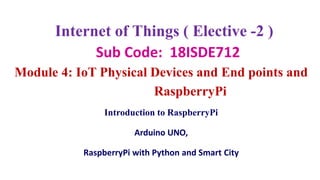

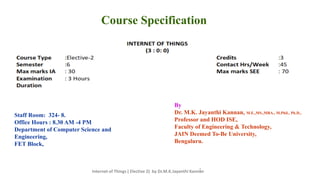
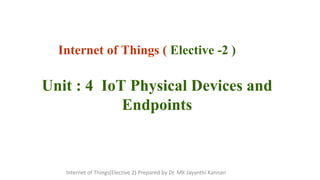
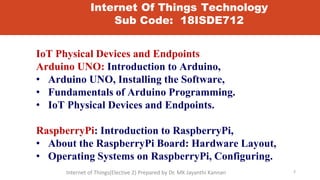



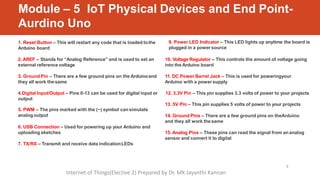


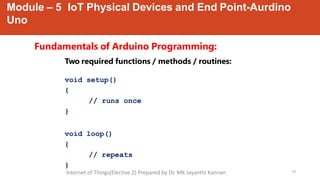

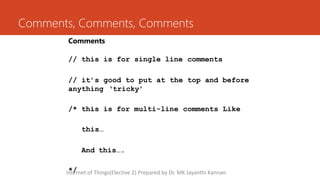
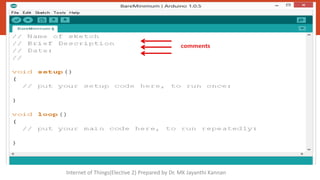

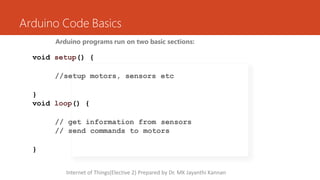
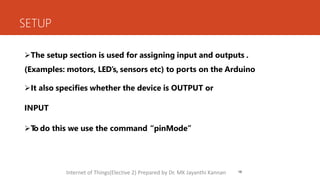

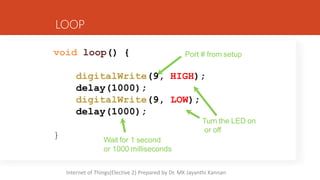





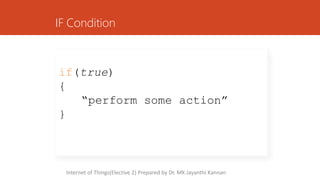
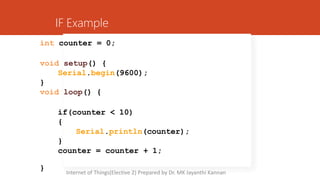
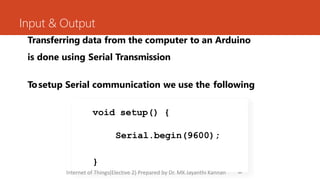

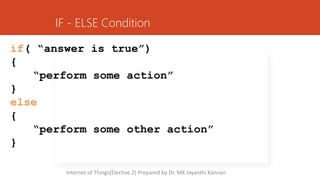
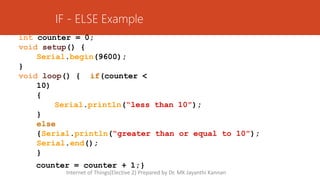

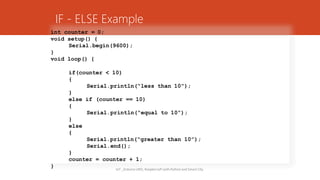





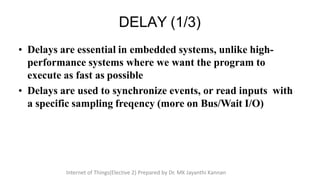
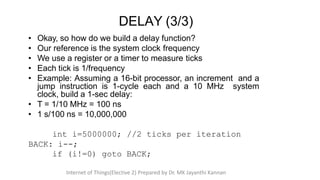
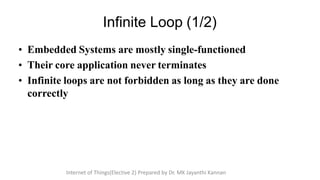
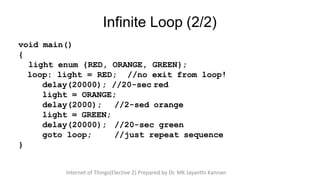
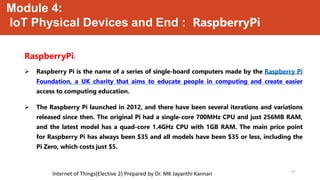


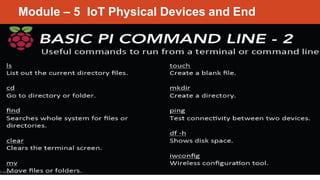


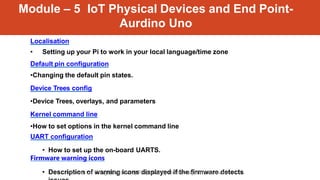
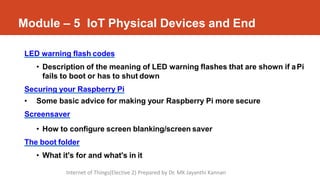
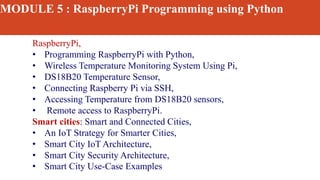
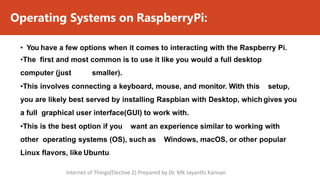


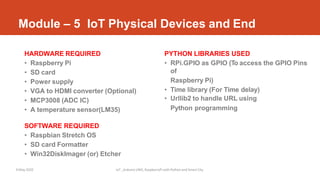

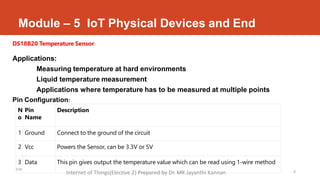
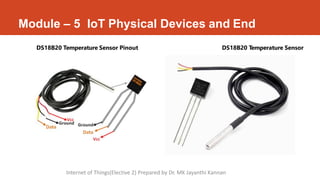

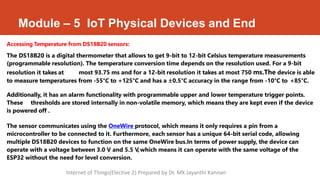

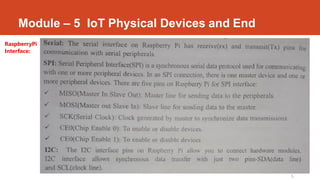

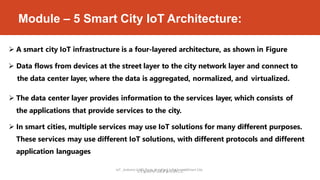


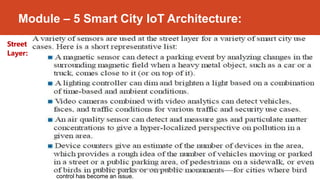


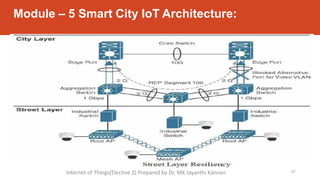
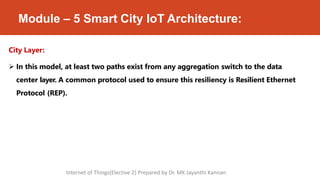




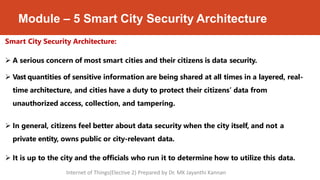
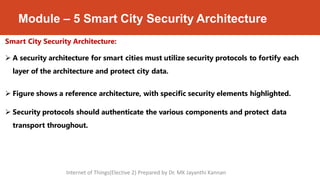
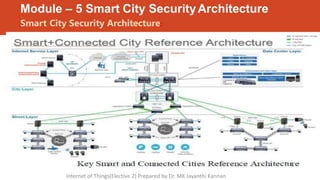
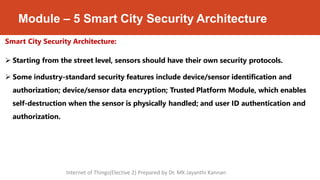
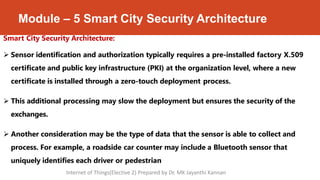
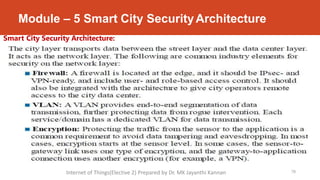



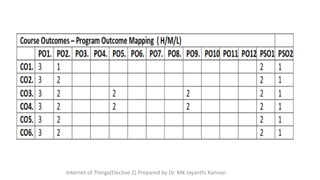
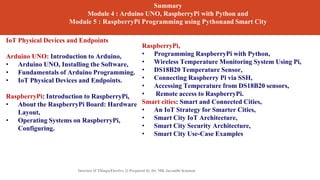
















![Introduction to ESP32 Programming [Road to RIoT 2017]](https://cdn.slidesharecdn.com/ss_thumbnails/roadtoriotsurabayagettingstartedesp32-170726155154-thumbnail.jpg?width=560&fit=bounds)




























































